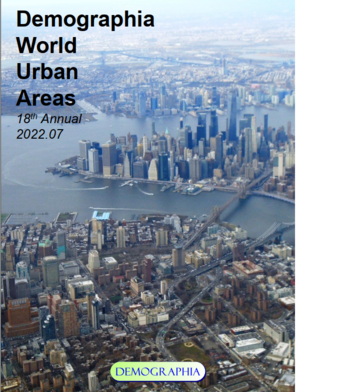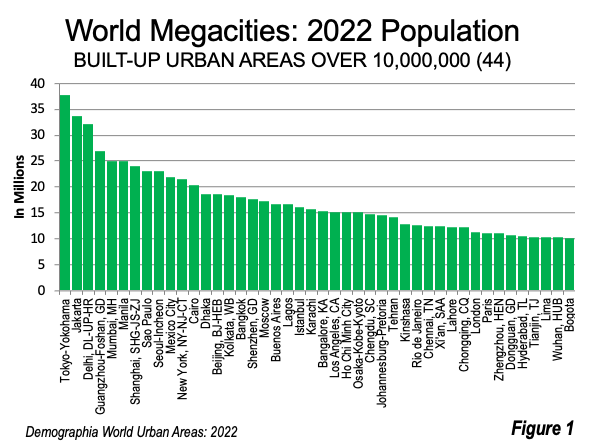
The 2022 edition of Demographia World Urban Areas has been released, which provides revised population estimates based on the 2020 round of censuses, though some censuses have been delayed due to the pandemic (such as in India and Bangladesh).
Demographia World Urban Areas contains population, land area and population density for the 990 identified built-up urban areas in the world with 500,000 or more population. The total population of these urban areas is estimated at 2.36 billion, representing 52 percent of the world urban population in 2022. The world urban population has risen to 57 percent of the total population in 2022.
Megacities (Over 10 Million Population)
There are 44 megacities (urban areas of at least 10 million population) This is an increase of eight from 36 to 44. Five were in China (Chongqing, Xi’an, Zhengzhou, Dongguan and Wuhan). The other new megacities were Hyderabad (India), Lima, and Bogota. Overall, China has 11 megacities, followed by India with six, with Brazil, Japan, Pakistan and the United States each having two. There are a total of 97 urban areas with at least 5,000,000 residents, up from 90 last year. The megacities are illustrated in Figure 1.

Most Significant Developments in the Last Year
Tokyo-Yokohama: Top ranked Tokyo-Yokohama is estimated to have a lower population than reported last year. This is the result of early 2020s Ministry of Communications estimates that show lower population growth rates.
Jakarta: Second ranked Jakarta reflects a population reduction from last year, as a result of a substantially reduced growth rate between the 2015 and 2020 censuses. Jakarta is the largest urban area in the southern hemisphere.
Guangzhou-Foshan is now estimated to be the fourth largest urban area in the world, following Tokyo-Yokohama, Jakarta, and Delhi. The population is estimated at 26.9 million. Population growth was considerably faster than expected between the 2010 and 2020 censuses. The metropolitan area that encompasses the urban area (the municipalities of Guangzhou and Foshan) added more than 8 million residents between the 2010 and 2020 censuses. This is among the largest decadal metropolitan area increase in history.
Guangzhou-Foshan is one of three adjacent megacities in China’s Greater Bay Area (Pearl River Delta). These include Dongguan, adjacent to the south of Guangzhou-Foshan, and Shenzhen adjacent to the south of Dongguan.
Mumbai ranks as the fifth largest urban area in the world, with India accounting for two of the five the largest urban areas (along with third ranked Delhi).
Manila is the sixth largest urban area, nearly equaling the population of Mumbai.
Shanghai: Seventh ranked Shanghai experienced significantly lower growth since 2010 than in the previous decade, when it gained nearly seven million residents. Shanghai has implemented policies to limit population growth, along with 14th ranked Beijing. This became evident in mid- 2010s, with municipality reports Indicating much lower growth rates (See related article: Beijing and Shanghai Limit Population Growth).
Sao Paulo ranks as the eighth largest urban area, the largest in the western hemisphere and the second largest in the southern hemisphere.
Seoul, as the ninth largest urban area and the only representative in the top ten from a high income nation.
Mexico City is the 10th largest urban area and the largest urban area in the western hemisphere.
New York is the 11th largest. New York was the world’s largest urban area from about 1920 to 1950 and was ranked third largest in the world as late as 1990 (following Tokyo-Yokohama and Osaka-Kobe-Kyoto).
The Meaning of 57% Urban
In recent years, the world has become more than one-half urban for the first time in history (57 percent in 2022). Yet, it would be a mistake to believe that the world's urban residents live in settings similar to 5th Avenue in New York or within the fourth ring road of Beijing or in inner Paris, or for that matter in large urban areas. Virtually all of the world’s large urban areas have extensive suburbs of much lower density outside the historic cores that are characterized by higher densities. Moreover, some urban areas that largely developed after post-World War II, with its preponderance of an automobile oriented urban form, have little or no high-density urban core (See: What is a Half-Urban World?)
In 2022, the median world urban resident lives in an urban area with a population of approximately 625,000. This would include for example, Springfield, MA-CT in the United States as well as Wroclaw, Poland, Geneva, Puyang, Henan, China and Jeonju, South Korea.
Contents of Demographia World Urban Areas: 2022
Demographia World Urban Areas includes the following sections, with estimates of urban population, urban land area and urban population density for each of the 990 urban areas.
Technical Introduction
Schedule 1: World Summary
Schedule 2: Largest Built-Up Urban Areas in the World
Schedule 3: Built-Up Urban Areas Ranked by Land Area (Urban Footprint)
Schedule 4: Built-Up Urban Areas Ranked by Urban Population Density
Schedule 5: Alphabetical List of Built-Up Urban Areas
The Future: In the Less Developed World
Future population growth is expected to be dominated by urban areas outside those in the highest income geographies. The just released United Nations World Population Prospects: 2022 projects that between this year and 2100, just over 100% of population growth will be in the less developed world. The more developed world (North America, which includes Canada, the United States and some Caribbean islands), Europe, Japan, Australia and New Zealand, is expected to lose 122 million residents. This is approximately equal to the present population of Japan. The less developed world is projected to add 2.5 billion residents, 106 percent of the population growth.
This suggests that the, as time goes on, the largest world urban areas will include even fewer from the more developed world than the already modest share.
Note: Parts of this article are adapted from the Technical Appendix.
Wendell Cox is principal of Demographia, an international public policy firm located in the St. Louis metropolitan area. He is a founding senior fellow at the Urban Reform Institute, Houston, a Senior Fellow with the Frontier Centre for Public Policy in Winnipeg and a member of the Advisory Board of the Center for Demographics and Policy at Chapman University in Orange, California. He has served as a visiting professor at the Conservatoire National des Arts et Metiers in Paris. His principal interests are economics, poverty alleviation, demographics, urban policy and transport. He is co-author of the annual Demographia International Housing Affordability Survey and author of Demographia World Urban Areas.
Mayor Tom Bradley appointed him to three terms on the Los Angeles County Transportation Commission (1977-1985) and Speaker of the House Newt Gingrich appointed him to the Amtrak Reform Council, to complete the unexpired term of New Jersey Governor Christine Todd Whitman (1999-2002). He is author of War on the Dream: How Anti-Sprawl Policy Threatens the Quality of Life and Toward More Prosperous Cities: A Framing Essay on Urban Areas, Transport, Planning and the Dimensions of Sustainability.
Photograph: Cover, Demographia World Urban Areas: 2022 Edition (New York: Downtown Brooklyn, Lower Manhattan and Exchange Place, Jersey City, by author).













Lima, Bogota
Wonder what role the growth of these megacities may be playing in political shifts(to the left) in their respective countries.